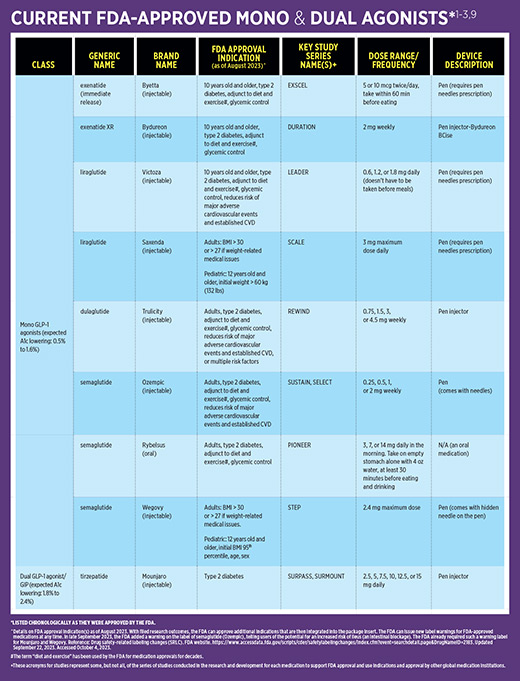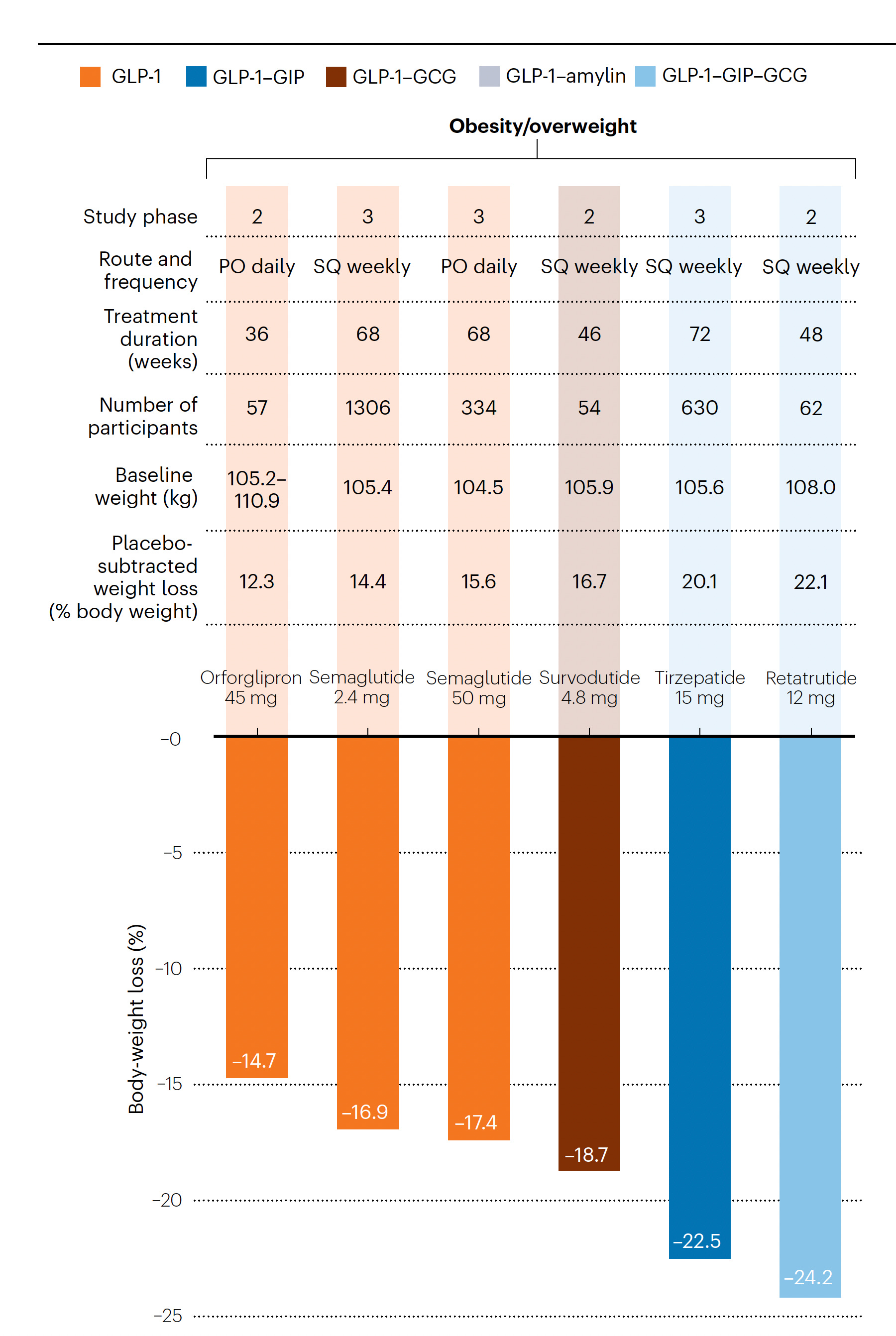GLP-1 weight management involves using glucagon-like peptide-1 agonists to help control appetite and blood sugar levels. These medications support weight loss and improve metabolic health.
GLP-1 agonists are a class of medications that mimic the GLP-1 hormone, which plays a crucial role in regulating appetite and insulin secretion. These drugs help reduce hunger, making it easier to manage calorie intake and promote weight loss. They also improve glycemic control, benefiting individuals with type 2 diabetes.
GLP-1 agonists are typically administered through injections and have shown promising results in clinical trials for weight management. Patients using GLP-1 agonists often experience significant weight loss and improved metabolic health markers. Always consult a healthcare provider to determine if GLP-1 agonists are suitable for your weight management plan.

Credit: www.todaysdietitian.com
The Science Behind Glp-1 And Weight Loss
GLP-1, or glucagon-like peptide-1, is a hormone in our body. It plays a crucial role in weight management and blood sugar control. This hormone can help reduce appetite and regulate blood sugar levels.
How Glp-1 Affects Appetite
GLP-1 helps control hunger. It signals the brain that we are full. This reduces our urge to eat more food.
When GLP-1 levels are high, people feel less hungry. This makes it easier to stick to a diet. It helps in reducing weight effectively.
Glp-1’s Role In Blood Sugar Regulation
GLP-1 also helps manage blood sugar levels. It stimulates the release of insulin from the pancreas.
Insulin helps lower blood sugar after eating. GLP-1 slows down how fast the stomach empties food into the intestines. This helps keep blood sugar levels stable.
| GLP-1 Functions | Benefits |
|---|---|
| Reduces Appetite | Aids in Weight Loss |
| Regulates Blood Sugar | Prevents Blood Sugar Spikes |
- Reduces Hunger: Makes you feel full longer.
- Regulates Blood Sugar: Keeps blood sugar levels stable.
Glp-1 Agonists: A New Era In Weight Management
Weight management has always been a challenge for many individuals. GLP-1 agonists are now changing the game. These drugs offer new hope for effective weight loss. They work by mimicking natural hormones in the body. This helps control appetite and food intake.
Types Of Glp-1 Agonists Available
Several types of GLP-1 agonists are currently available. Each has unique features and benefits.
| Drug Name | Brand Name | Dosage Form |
|---|---|---|
| Liraglutide | Saxenda | Injection |
| Semaglutide | Wegovy | Injection |
| Exenatide | Byetta | Injection |
These medications are typically administered through injections. They are designed to be used alongside a reduced-calorie diet and increased physical activity.
Comparing Glp-1 Agonists To Traditional Weight Loss Medications
GLP-1 agonists are different from traditional weight loss drugs. Here are some key comparisons:
- Mechanism of Action: GLP-1 agonists mimic natural hormones. Traditional drugs often suppress appetite or increase metabolism.
- Side Effects: GLP-1 agonists may cause nausea. Traditional medications can have more severe side effects.
- Long-term Use: GLP-1 agonists are designed for long-term use. Many traditional drugs are only for short-term use.
GLP-1 agonists provide a promising alternative for those struggling with weight loss. Their unique action and benefits make them a valuable tool in modern weight management.
Real World Results: Success Stories And Statistics
GLP-1 therapy has changed many lives. People have lost weight and gained confidence. Real-world success stories and statistics show its effectiveness. This section dives deep into personal experiences and data analysis.
Case Studies Of Glp-1 Induced Weight Loss
John, a 45-year-old man, struggled with weight. After six months on GLP-1, he lost 30 pounds. He felt more energetic and confident.
Sarah, a 38-year-old woman, had tried many diets. GLP-1 helped her shed 25 pounds in five months. Her health improved significantly.
These stories highlight the potential of GLP-1 therapy. Many people have seen similar results.
Analyzing The Data: How Effective Is Glp-1 Therapy?
Studies show that GLP-1 therapy leads to significant weight loss. In a clinical trial, participants lost an average of 15% of their body weight.
| Study | Participants | Average Weight Loss |
|---|---|---|
| Study 1 | 200 | 12% |
| Study 2 | 150 | 15% |
| Study 3 | 100 | 18% |
As the table shows, weight loss varies but is substantial. Many people benefit from GLP-1 therapy.
GLP-1 therapy has proven effective in real-world settings. Success stories and data back this up.

Credit: erictopol.substack.com
Incorporating Glp-1 Therapy Into Your Weight Loss Plan
GLP-1 therapy can enhance your weight loss journey. This therapy involves using medications that mimic the GLP-1 hormone. This hormone helps regulate appetite and blood sugar levels. Combining GLP-1 therapy with a balanced diet and exercise can yield impressive results.
Consulting With Healthcare Providers
Before starting GLP-1 therapy, consult with your healthcare provider. They can assess your current health status. Discuss your weight loss goals and medical history. Your provider will determine if GLP-1 therapy is suitable for you. Always follow their guidance for safe and effective results.
Designing A Personalized Glp-1 Weight Management Program
A personalized program is essential for success. Your healthcare provider will customize a plan tailored to your needs. This plan will include dosage, diet, and exercise recommendations. Regular follow-ups ensure your progress is monitored and adjustments are made as needed.
| Component | Details |
|---|---|
| Dosage | Your provider will prescribe the right dosage for you. Stick to the prescribed dose for optimal results. |
| Diet | Follow a balanced diet rich in nutrients. Include lean proteins, vegetables, and whole grains. Avoid processed foods and sugary drinks. |
| Exercise | Engage in regular physical activity. Aim for at least 30 minutes of exercise most days of the week. |
Adhering to your personalized program can help you achieve your weight loss goals. Stay committed and communicate any concerns with your healthcare provider.
Potential Side Effects And How To Manage Them
GLP-1 agonists are effective for weight management. Yet, they may have side effects. Understanding these side effects and managing them helps ensure a smoother experience.
Common Adverse Reactions To Glp-1 Agonists
Some common side effects include:
- Nausea: This is the most common side effect.
- Vomiting: Often follows nausea if not managed.
- Diarrhea: May occur with gastrointestinal upset.
- Constipation: Some users experience the opposite of diarrhea.
- Headache: A frequent complaint among users.
Tips For Minimizing Side Effects
Here are ways to manage and reduce side effects:
- Start with a low dose: Gradually increase to minimize nausea.
- Eat smaller meals: Large meals can worsen nausea and vomiting.
- Stay hydrated: Drink plenty of water to avoid constipation and headaches.
- Avoid fatty foods: They can increase gastrointestinal upset.
- Consult your doctor: Speak with your healthcare provider if side effects persist.
| Side Effect | Management Tip |
|---|---|
| Nausea | Start with a low dose |
| Vomiting | Eat smaller meals |
| Diarrhea | Avoid fatty foods |
| Constipation | Stay hydrated |
| Headache | Consult your doctor |

Credit: www.healthline.com
Lifestyle Choices That Complement Glp-1 Therapy
GLP-1 therapy can be effective for weight management. Maximizing its benefits involves adopting certain lifestyle choices. These choices include specific dietary habits and exercise routines. Together, they enhance the therapy’s effectiveness.
Dietary Recommendations For Optimized Results
A balanced diet is crucial. Eating whole foods like vegetables, fruits, and lean proteins can boost results. Avoid processed foods high in sugars and fats.
Consider the following dietary guidelines:
- Consume more fiber-rich foods such as beans, oats, and whole grains.
- Include healthy fats like avocados, nuts, and olive oil.
- Drink plenty of water to stay hydrated.
| Food Group | Examples | Benefits |
|---|---|---|
| Vegetables | Broccoli, Spinach, Carrots | Rich in vitamins and minerals |
| Fruits | Apples, Berries, Oranges | High in antioxidants |
| Proteins | Chicken, Fish, Tofu | Builds and repairs tissues |
Exercise And Glp-1: Finding The Balance
Exercise complements GLP-1 therapy. Regular physical activity helps in weight loss and overall health.
Here are some exercise tips to consider:
- Start with moderate-intensity exercises like walking or cycling.
- Include strength training exercises twice a week.
- Find activities you enjoy to stay motivated.
Remember, consistency is key. Aim for at least 150 minutes of exercise per week.
The Future Of Glp-1 In Obesity And Metabolic Health
GLP-1, or glucagon-like peptide-1, is transforming obesity treatment. It regulates appetite and blood sugar. The future promises even more exciting developments. Let’s explore the potential breakthroughs.
Emerging Research On Glp-1
Researchers are studying GLP-1’s impact on weight loss. Early studies show promising results. GLP-1 helps people feel full longer. This reduces the urge to overeat.
Scientists also examine GLP-1’s role in metabolic health. It helps regulate blood sugar levels. This is crucial for managing diabetes. New findings suggest GLP-1 could improve heart health too.
One study showed that GLP-1 reduces inflammation. This is important for overall health. Reduced inflammation means a lower risk of chronic diseases.
Predictions For New Glp-1-Based Treatments
Experts predict new GLP-1-based treatments soon. These treatments could be more effective. They might have fewer side effects too.
Future GLP-1 medications could come in different forms. Pills, injections, or even patches could be options. This would make treatment more convenient.
Researchers are also exploring combination therapies. GLP-1 with other medications could boost results. This could lead to better weight management solutions.
New GLP-1 treatments might target specific groups. For example, people with specific genetic profiles. This personalized approach could enhance effectiveness.
| Research Area | Potential Benefits |
|---|---|
| Weight Loss | Reduced appetite, longer fullness |
| Metabolic Health | Better blood sugar regulation |
| Heart Health | Lower inflammation reduces disease risk |
| Personalized Treatments | Targeted therapies for specific groups |
Navigating Access And Affordability Of Glp-1 Treatments
GLP-1 treatments have gained popularity in weight management. They offer promising results. Yet, access and affordability remain concerns for many. This section guides you through insurance coverage, patient assistance programs, and other resources.
Insurance Coverage And Cost Considerations
Insurance coverage for GLP-1 treatments varies. Check with your insurance provider. Some plans cover these treatments, while others do not. Understanding your plan helps you prepare financially.
Costs can be high without insurance. Monthly expenses range from $500 to $1,500. Ask your doctor about generic options. They might be more affordable.
| Insurance Status | Monthly Cost |
|---|---|
| Covered by Insurance | $50 – $100 |
| Not Covered by Insurance | $500 – $1,500 |
Patient Assistance Programs And Other Resources
Several patient assistance programs exist. They help reduce the cost of GLP-1 treatments. Look for programs from pharmaceutical companies. They often offer discounts or free medication for those who qualify.
Non-profit organizations can also help. They may provide financial assistance or other support. Check their eligibility criteria.
- Pharmaceutical Company Programs
- Non-Profit Organizations
- Online Coupon Services
Online coupon services can offer significant savings. Websites like GoodRx provide discounts on prescriptions. Always compare prices before purchasing.
Frequently Asked Questions
What Is Glp-1 In Weight Management?
GLP-1 is a hormone that regulates appetite and insulin. It helps control blood sugar levels and promotes weight loss. GLP-1 medications mimic this hormone to aid in weight management.
How Does Glp-1 Help With Weight Loss?
GLP-1 slows stomach emptying, making you feel full longer. It reduces appetite and curbs overeating. This leads to effective weight management and loss.
Are Glp-1 Medications Safe?
GLP-1 medications are generally safe when prescribed by a doctor. They may have side effects like nausea. Always consult your healthcare provider for personalized advice.
Who Can Benefit From Glp-1 Treatments?
Individuals struggling with obesity or type 2 diabetes can benefit. GLP-1 treatments help in managing weight and blood sugar levels. Consult your doctor to see if it’s right for you.
Conclusion
Discovering the benefits of GLP-1 for weight management can transform your journey. This method offers a sustainable approach. Embrace a healthier lifestyle and achieve your goals. Always consult with a healthcare professional before starting any treatment. Stay committed, and let GLP-1 support your weight loss efforts effectively and safely.




